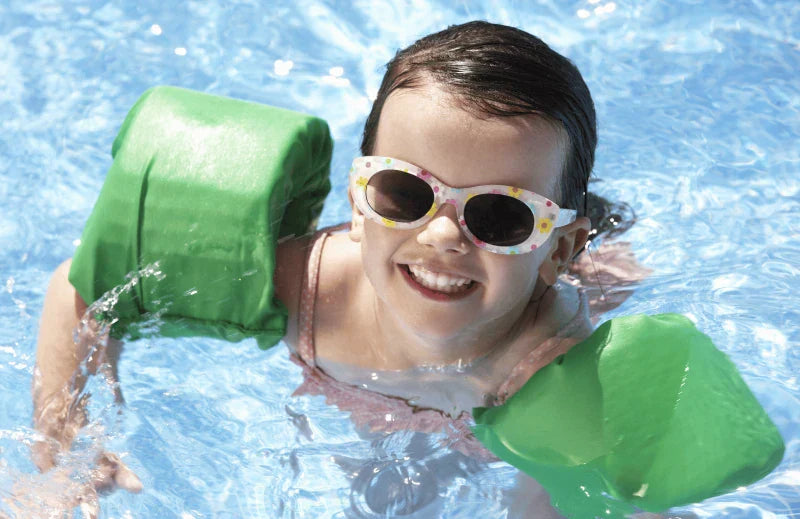This article discusses the subject of armbands and is part of a series of articles on: Do flotation devices (like PFD) protect against drowning?
Introduction
Summer is often synonymous with swimming and water games for children. To make the most of these moments in complete safety, many parents turn to armbands. But are they really effective in preventing drowning?
Let's kill the suspense straight away: the answer is no. Armbands can be a good way for children to discover the water and gain confidence at the start of their swimming lessons, but they do not protect against drowning.
How do armbands work?
Armbands are flotation devices that are placed around the arms. They make it easier for children to float and stay afloat. However, it is important to know that they are not designed to prevent drowning. They only improve flotation and do not guarantee that the child will not roll over or slip out of the armbands.
These are buoyancy aids governed by European standard EN 13138-1. According to this standard, it is compulsory for the instructions for use of armbands to state that this equipment does not protect against drowning. This is not life-saving equipment such as lifejackets, which are governed by standard EN ISO 12402.
The different types of armbands and essential components
There are different types of armbands, more or less adapted to the age and weight of the child:
- Inflatable armbands: these are the most common and the most economical. They are easy to carry and store.
- Foam armbands: these are more resistant and durable than inflatable armbands. They provide better flotation and are more suitable for children who have just started learning to swim.
- Puddle Jumpers: these combine the advantages of armbands and swimming belts. They allow children to float while keeping their arms free to learn to swim.
Certain essential elements must be in evidence:
- CE marking: armbands must bear the CE marking, which certifies that they comply with European safety standards. There is the equivalent for the United Kingdom with the UKCA marking.
- Standard EN 13138-1: this standard specifies the safety requirements and test methods applicable to buoyancy aids for swimming.
- Age and weight: the armbands must indicate the minimum and maximum age and weight of the child for whom they are designed.
- Safety warnings: armbands must carry clear and legible safety warnings, such as ‘Does not protect against drowning’ and ‘Use under adult supervision’.
Whatever type of armband you choose, it's important to check that it complies with the applicable safety standards and is suitable for your child's height and weight. In the case of inflatable armbands, it's also important to check that they are correctly inflated (neither too much nor too little) and that there are no leaks.
Under what conditions are armbands used?
Armbands are designed for children who are beginning to familiarise themselves with water and need support to float. They are particularly suitable for children who are learning to swim and need to feel safe in the water.
However, it is important to be aware that it is not generally recommended to use armbands when learning to swim. Armbands can give children a false sense of security and prevent them from developing the skills they need to swim properly. The extra buoyancy provided by armbands does not allow the child to be in real-life conditions and therefore to fully acquire the technique and strength needed to stay afloat on their own. Not to mention the fact that armbands can be counter-productive, as they make it more difficult for children to put their head underwater: they don't acquire the ease needed to surface calmly, and can panic as soon as they lose their footing or when an armband slips.
Armbands can be useful for children who are not yet strong enough to stay afloat on their own, and to help them gain confidence. But learning to swim or at least life-saving techniques as soon as possible without armbands is still the best way to go.
Armbands are by no means a 100% guarantee of safety. They are not a substitute for permanent and constant adult supervision. It is essential never to leave a child unsupervised near water, even if they are wearing armbands.
Safety tips
Whatever buoyancy aid you choose, it is essential to observe the following safety instructions:
- Never leave children unsupervised near water, even if they are wearing armbands or other flotation devices. Adults must be constantly vigilant.
- Teaching your child to swim from an early age. Most programmes start at the age of 4, but it is also possible to learn lifesaving reflexes even earlier.
- Choose supervised bathing areas.
- Respect safety instructions and swimming bans.
Armbands can be an important aid when it comes to learning to swim and becoming familiar with the water. However, they are by no means a 100% guarantee of safety and are no substitute for constant adult supervision.
Equipment designed to save from drowning includes lifejackets or anti-drowning solutions, falling under the ISO 12402 standard.




